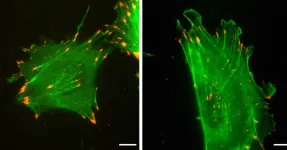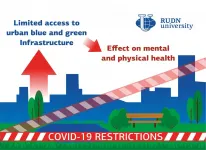(Press-News.org) Astronomers have designed and trained a computer program which can classify tens of thousands of galaxies in just a few seconds, a task that usually takes months to accomplish.
In research published today, astrophysicists from Australia have used machine learning to speed up a process that is often done manually by astronomers and citizen scientists around the world.
"Galaxies come in different shapes and sizes" said lead author Mitchell Cavanagh, a PhD candidate based at The University of Western Australia node of the International Centre for Radio Astronomy Research (ICRAR).
"Classifying the shapes of galaxies is an important step in understanding their formation and evolution, and can even shed light on the nature of the Universe itself."
Mr Cavanagh said that with larger surveys of the sky happening all the time, astronomers are collecting too many galaxies to look at and classify on their own.
"We're talking several million galaxies over the next few years. Sometimes citizen scientists are recruited to help classify galaxy shapes in projects like Galaxy Zoo, but this still takes time."
This is where convolutional neural networks, or CNNs, come in. In today's high-tech world, these kinds of computer programs are everywhere, used in everything from medical imaging, stock markets and data analytics, to how Netflix generates recommendations based on your viewing history.
In recent years, CNNs have begun to see wider adoption in astronomy. Most of the existing CNNs that astronomers use are binary - is this a spiral galaxy or not? - but this new CNN uses multiclass classification - is this an elliptical, lenticular, spiral, or irregular galaxy? - with more accuracy than the existing binary networks.
Mr Cavanagh said that machine learning is becoming more widespread in astronomy.
"The massive advantage of neural networks is speed. Survey images that would otherwise have taken months to be classified by humans can instead be classified in mere minutes."
"Using a standard graphics card, we can classify 14,000 galaxies in less than 3 seconds."
"These neural networks are not necessarily going to be better than people because they're trained by people, but they're getting close with more than 80% accuracy, and up to 97% when classifying between ellipticals and spirals."
"If you place a group of astronomers into a room and ask them to classify a bunch of images, there will almost certainly be disagreements. This inherent uncertainty is the limiting factor in any AI model trained on labelled data."
One great advantage of this new AI is that the researchers will be able to classify more than 100,000,000 galaxies at different distances (or redshifts) from Earth and in different environments (groups, clusters etc). This will help them understand how galaxies are being transformed over time, and why it might happen in particular environments.
The CNNs that Mr Cavanagh has developed aren't just for astronomy. They can be repurposed for use in many other fields, as long as they have a large enough dataset to train with.
"CNNs will play an increasingly important role in the future of data processing, especially as fields like astronomy grapple with the challenges of big data," he said
INFORMATION:
MORE INFORMATION
ICRAR
The International Centre for Radio Astronomy Research (ICRAR) is a joint venture between Curtin University and The University of Western Australia with support and funding from the State Government of Western Australia.
http://www.icrar.org
GALAXY ZOO
Galaxy Zoo is a crowdsourced astronomy project which invites people to assist in the morphological classification of large numbers of galaxies, and has been operating since 2017. This paper uses Galaxy Zoo images to help train the algorithm, but you can also sign up to take part in Galaxy Zoo citizen science yourself.
https://www.zooniverse.org/projects/zookeeper/galaxy-zoo/
Most common bone and joint (orthopaedic) procedures, such hip replacements and shoulder repair surgery, are not backed up by high quality evidence, mainly because of a lack of definitive trials, suggests an analysis of data published by The BMJ today.
Yet despite the lack of strong supporting evidence, some of these procedures are still recommended by national guidelines in certain situations, the findings show.
Musculoskeletal conditions affect around 1 in 4 UK adults and account for over 25% of all NHS surgical interventions at a cost of £4.76 billion each year.
National ...
Muscle relaxant drugs are largely ineffective for low back pain, despite being widely prescribed for this condition, suggests an analysis of the latest evidence published by The BMJ today.
The findings show that muscle relaxants might reduce pain in the short term, but the effect is too small to be considered clinically meaningful, and there is an increased risk of side effects.
But the researchers stress that the certainty of evidence is low and say large trials are urgently needed to resolve uncertainties around the use of these drugs for back pain.
Low back pain is a global public health problem and muscle relaxants (a broad class of drugs that include ...
Mandatory covid-19 vaccination for care home workers is unnecessary, disproportionate and misguided, warn experts
And is based on unreliable data
In The BMJ today, experts argue that mandatory vaccination is "unnecessary, disproportionate, and misguided."
The government decision to remove the right of care home staff in England to choose whether or not to be vaccinated against covid-19 is a profound departure from public health norms. The intended next step is a rapid and massive expansion of compulsory vaccination to legally require covid-19 and flu vaccination of all frontline health and social care workers, subject to consultation.
But Lydia Hayes, Professor of Law at Kent ...
An estimated 8.4 billion people could be at risk from malaria and dengue by the end of the century if emissions keep rising at current levels, according to a new study published in The Lancet Planetary Health.
The research team estimates that this worst-case scenario would mean the population at risk of the diseases might increase by up to 4.7 additional billion people (relative to the period 1970-1999), particularly in lowlands and urban areas, if temperatures rise by about 3.7°C 1 by 2100 compared to pre-industrial levels.
The study was led by the London School of Hygiene & Tropical Medicine (LSHTM) with partners from Umeå University, Sweden; Abdus Salam ...
LOS ANGELES - A new prognostic tool developed by researchers from the UCLA Jonsson Comprehensive Cancer Center and five other institutions helps predict which men with advanced metastatic prostate cancer will respond favorably to a novel targeted therapy.
The tool, described in a study published today in Lancet Oncology, analyzes a wide spectrum of imaging and clinical data and is intended to assist physicians considering treating patients with Lutetium-177 prostate-specific membrane antigen, or LuPSMA.
LuPSMA, which binds to PSMA proteins and delivers targeted radiation to prostate cancer tissue, offers a new option to men with PSMA-positive metastatic cancer that is castration-resistant, meaning it has stopped ...
The protein actin is ubiquitous and essential for life. In mammals, every cell expresses two of its forms, beta-actin and gamma-nonmuscle-actin. Despite having distinct roles, the two forms are nearly identical, sharing 99% of their amino acid sequence.
Research by Anna Kashina of Penn's School of Veterinary Medicine and colleagues has shown that, contrary to scientific dogma, it's not the slight differences in amino acid sequence that govern these proteins' discrete functions in the cell. Rather, their nucleotide sequences--the "letters" that make up their DNA coding sequence, which differ by roughly 13% between the two forms--are responsible for their individual roles in organisms' ...
Researchers have produced vaccine-like immune responses to a dangerous bacterium by colonizing 26 healthy volunteers with a related, but harmless, commensal bacterial species. The first-in-human, controlled infection study showed the strategy was safe, as no side effects were reported and the volunteers didn't transmit the commensal bacteria to bedroom-sharers over the 90-day study. Neisseria lactamica is a member of the microbiome that usually resides in the upper airways of children but can also safely colonize the airways of adults. Some researchers theorize that these bacteria ...
By 2050, faster adoption of electric vehicles (EVs) and faster generation of renewable energy will result in 99% less fossil fuel consumed and 93% less CO2 emissions from passenger and freight vehicles on O?ahu. That's under the most ambitious scenario in an article published in World Electric Vehicle Journal, by University of Hawai?i at Mānoa School of Ocean and Earth Science and Technology (SOEST) faculty member Katherine McKenzie.
McKenzie, based at the Hawai?i Natural Energy Institute in SOEST, created mathematical models of four scenarios based on projections for the switch to electric passenger and freight ...
Five years ago, researchers at Northwestern University made international headlines when they discovered that human eggs, when fertilized by sperm, release billions of zinc ions, dubbed "zinc sparks."
Now, Northwestern has teamed up with the U.S. Department of Energy's (DOE) Argonne National Laboratory and Michigan State University (MSU) to reveal that these same sparks fly from highly specialized metal-loaded compartments at the egg surface when frog eggs are fertilized. This means that the early chemistry of conception has evolutionary roots going back at least 300 million years, to the last common ancestor between frogs and people.
"This work may help inform our understanding of the interplay of dietary zinc status and human fertility." -- Thomas O'Halloran, professor, Michigan State ...
The measures taken during the COVID-19 pandemic limited the access of citizens to natural objects. It is still unexplored, what consequences this had for the residents and what conclusions should be drawn for more effective urban planning. RUDN University scientists with colleagues from Australia and Germany studied how the restrictions associated with COVID-19 affected the use of blue and green infrastructure by citizens in Moscow (Russia) and Perth (Australia), and what consequences this had for their health. In the article "Human Dimensions of Urban Blue and Green Infrastructure during a Pandemic. The Case Study of Moscow (Russia) ...




